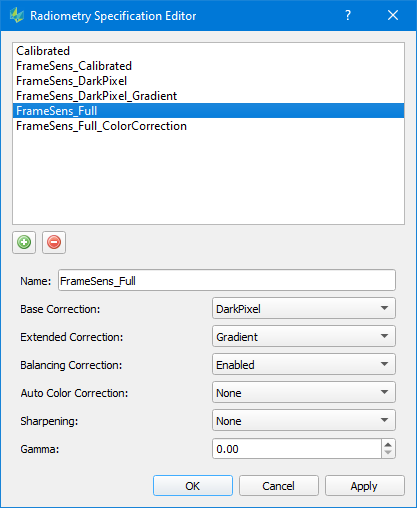Defining Radiometry Specification Templates
The radiometry template defines all the radiometric corrections that are applied to the output product for both images and point clouds. By clicking on the green plus icon a new radiometry template is created. Note that the order of the corrections is significant in that they are applied from top to bottom.

Name:
Name of the template. It is recommended to have an explicit name for better reference.Base Correction:
"Calibrated" – produces Apparent Reflectance image output
"DarkPixel" – produces Apparent Reflectance image output including a dark pixel correction
Extended Correction:
The extended correction sits on top of the base correction.“Gradient” – can be added on top of a DarkPixel corrected image, removes brightness gradient within an image
Balancing Correction
If enabled, a radiometric normalization is calculated per session with the goal to provide a radiometric homogenous session. In case of of DMC and systems based on RCD30/MFC150, it requires DarkPixel and Gradient correction to be selected as well.Auto Color Correction
Correction is based on the sensor’s multispectral bandwidth, and offers the possibility to enhance saturation of the images. NOTE: The auto color correction is only available for sensor systems with MFC150 cameraSharpening
Option to apply an image sharpening filter to the output product. The available settings for Sharpening:"Mild", "Medium", "Strong": luminance convolution filter applied uniformly across entire image. All with 3x3 kernel size, and increasing strength from “Mild” to “Strong”.
"Selective_Medium", "Selective_Strong": luminance convolution filter selectively applied to enhance edges. Selective_Medium with 3x3 kernel size, Selective_Strong with 5x5 kernel size.
Gamma:
Gamma correction that can be applied to the product.It’s not recommended to provide a setting here, if a radiometric profile will be used.